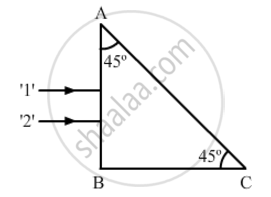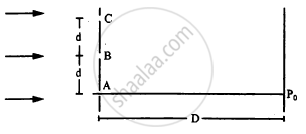Advertisements
Advertisements
Question
Monochromatic light of wavelength 600 nm is incident from the air on a water surface. The refractive index of water is 1.33. Find the
- wavelength,
- frequency and
- speed, of reflected and refracted light.
Solution
Given: λ = 600 nm, µ = 1.33
(i) In reflection, the ray will reflect back in the same medium as that of the incident ray.
Hence, wavelength (λ) = 600 nm
(ii) Frequency = υ = `"c"/λ = (3 xx 10^8)/(600 xx 10^-9)`
= 0.5 × 1015 Hz
(iii) Speed = 3 × 108 ms−1
In refraction, the speed and wavelength change while the frequency remains the same.
Hence, speed = ν = `"c"/µ = (3 xx 10^8)/(1.33)`
= 2.26 × 108 ms−1
Wavelength = λ = `ν/υ`
= `(2.26 xx 10^8)/(0.5 xx 10^15)`
= 4.52 × 10−7 m
= 452 nm
Frequency = υ = 0.5 × 1015 Hz
APPEARS IN
RELATED QUESTIONS
'Two independent monochromatic sources of light cannot produce a sustained interference pattern'. Give reason.
Two monochromatic rays of light are incident normally on the face AB of an isosceles right-angled prism ABC. The refractive indices of the glass prism for the two rays '1' and '2' are respectively 1.35 and 1.45. Trace the path of these rays after entering the prism.

In the wave picture of light, the intensity of light is determined by the square of the amplitude of the wave. What determines the intensity in the photon picture of light?
When monochromatic light is incident on a surface separating two media, why does the refracted light have the same frequency as that of the incident light?
Obtain the conditions for the bright and dark fringes in diffraction pattern due to a single narrow slit illuminated by a monochromatic source.
Explain clearly why the secondary maxima go on becoming weaker with increasing.
State Huygen’s principle. Using this principle explain how a diffraction pattern is obtained on a screen due to a narrow slit on which a narrow beam coming from a `=> n = (vlamda)/(vlamda_omega)`monochromatic source of light is incident normally.
The following figure shows three equidistant slits being illuminated by a monochromatic parallel beam of light. Let \[B P_0 - A P_0 = \lambda/3\text{ and }D > > \lambda.\] (a) Show that in this case \[d = \sqrt{2\lambda D/3}.\] (b) Show that the intensity at P0 is three times the intensity due to any of the three slits individually.

"Monochromatic light should be used to produce pure spectrum". Comment on this statement.
Monochromatic light of wavelength 650 nm falls normally on a slit of width 1.3 x 10-4 cm and the resulting Fraunhofer diffraction is obtained on a screen. Find the angular width of the . central maxima.
Answer the following question.
In the diffraction due to a single slit experiment, the aperture of the slit is 3 mm. If monochromatic light of wavelength 620 nm is incident normally on the slit, calculate the separation between the first order minima and the 3rd order maxima on one side of the screen. The distance between the slit and the screen is 1.5 m.
